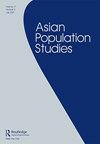Geospatial analysis of female fertility in Oman: do immigrant female domestic workers make a difference?
IF 1.5
4区 社会学
Q2 DEMOGRAPHY
引用次数: 0
Abstract
ABSTRACT Despite the progress achieved in transformational development in socioeconomic domains, in Oman, like other Gulf Cooperation Council states, fertility rates are higher compared with those in other Middle East nations. Reproductive behaviour often varies geographically; consequently, analysing and modelling this phenomenon should be conducted at subnational and finer levels to capture spatial heterogeneity patterns. In this research, data from the last Omani census are used and local indicators of spatial associations (LISA) as well as spatial econometric models have been employed to examine the effects of sociocultural factors, particularly foreign female domestic workers, on local fertility variations. Remarkable spatial differences were observed in the effects of structural covariates on fertility rates. Several spatial clusters indicate a correlation between higher fertility rates and higher values of other explanatory sociocultural variables. Furthermore, the subnational variations of fertility rates are significantly explained by geographical and sociocultural factors, such a surban-rural settlement, education, female employment in governmental sectors, unemployed women, and the proportion of foreign female domestic workers. The findings also reveal that the rural and Bedouin communities, particularly in the internal governorates, not only displayed higher fertility rates, but also had more unemployed women.阿曼女性生育能力的地理空间分析:移民女性家政工人有影响吗?
尽管在社会经济领域的转型发展取得了进展,但在阿曼,像其他海湾合作委员会国家一样,生育率高于其他中东国家。生殖行为往往因地而异;因此,应在国家以下和更精细的各级对这一现象进行分析和建模,以捕捉空间异质性格局。在这项研究中,使用了上次阿曼人口普查的数据,并采用了当地的空间关联指数以及空间计量模型来检查社会文化因素,特别是外籍女性家庭佣工对当地生育率变化的影响。结构协变量对生育率的影响存在显著的空间差异。一些空间集群表明,高生育率与其他解释性社会文化变量的高值之间存在相关性。此外,地方生育率的变化在很大程度上可以用地理和社会文化因素来解释,例如城乡定居、教育、政府部门的女性就业、失业妇女和外籍女性家政工人的比例。调查结果还显示,农村和贝都因社区,特别是内陆省份,不仅生育率较高,而且失业妇女也较多。
本文章由计算机程序翻译,如有差异,请以英文原文为准。
求助全文
约1分钟内获得全文
求助全文
来源期刊

Asian Population Studies
DEMOGRAPHY-
CiteScore
3.30
自引率
14.30%
发文量
12
期刊介绍:
The first international population journal to focus exclusively on population issues in Asia, Asian Population Studies publishes original research on matters related to population in this large, complex and rapidly changing region, and welcomes substantive empirical analyses, theoretical works, applied research, and contributions to methodology.
 求助内容:
求助内容: 应助结果提醒方式:
应助结果提醒方式:


